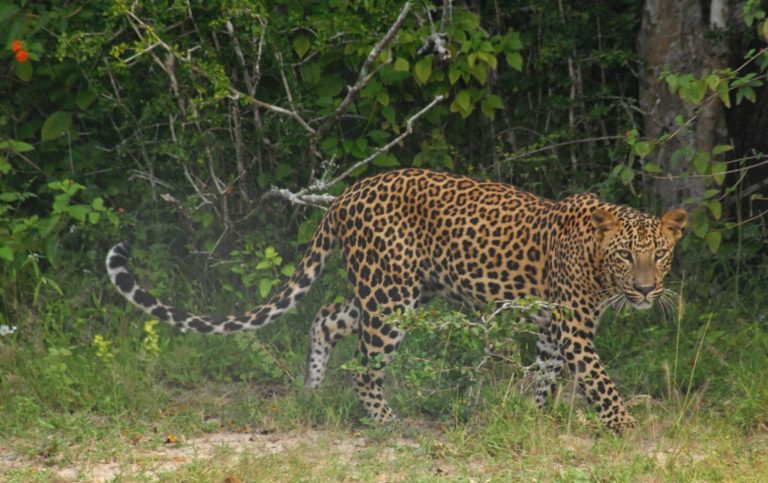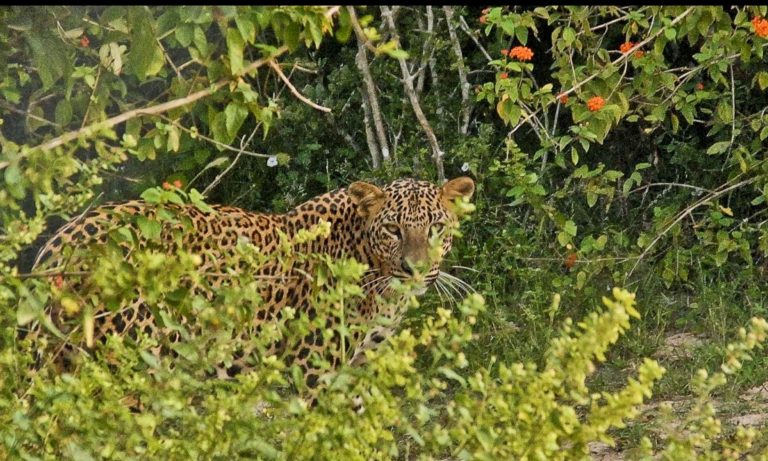- Among Sri Lanka’s charismatic species, the native subspecies of the leopard, Panthera pardus kotiya, is a favorite among wildlife enthusiasts and specialist photographers.
- Since 2018, there have been a spate of killings of leopards, including inside nature reserves, sparking concerns about the fate of a big cat population that has dwindled to an estimated 1,000 today.
- The leopard’s popularity among tourists and photographers has also led to disruptions in its habitat by large groups of visitors who cause traffic jams and noise in the midst of the wilderness.
- This post is a commentary. The views expressed are those of the author, not necessarily Mongabay.
COLOMBO — In recent years, leopards in Sri Lanka (Panthera pardus kotiya), an endangered subspecies native to the island, have been grabbing local and international headlines for all the wrong reasons.
At the end of last year an adult male leopard was found dead and mutilated at Uda Walawe National Park. The killers had allegedly targeted it for its teeth and claws, which are prized items on the black market. A year ago this month, a leopard was found dead in a trap near a tea plantation. In July 2018, an adult female and two juvenile leopards were found dead from eating a poisoned cow carcass in the Nilgala Forest Reserve; and a month earlier, a mob beat to death a leopard that had strayed into a village.
The animal’s population is dwindling, standing at an estimated 1,000 today, and its habitats are shrinking even as the number of threats to its survival grows. Despite its protected status, both nationally and globally, the leopard is becoming increasingly threatened, and the recent killings highlight the intensifying human-wildlife conflict that extends to leopards in Sri Lanka.

Fascinating leopard watching
Leopard watchers — and Sri Lanka has several whose research and photographic observations have contributed to our collective understanding of the charismatic big cat — are concerned about leopard conservation on the island. Visitors to national parks often complain that leopard sightings are becoming increasingly difficult.
Watching for leopards, as with any other species, requires the art of patience. Those with a trained eye for leopard spotting know that the prowler isn’t as easily captured on lens as, say, the elephant. There are certain times of the day and special nooks and corners that the big cats fancy. We need to know them or learn about them from park employees.

I’ve spent more than two decades photographing these majestic beasts. And during that time, my fascination for the leopard has simply refused to die. They are magnificent. Every photograph that has turned out right was a labor of love. Each click called for a patient wait, a bit like the way the big cat lies in wait for its prey. I’ve had the fortune to record them in a variety of moods and actions.
Anticipating their behavior is just as key as patient observation. Leopards are such fascinating creatures to observe, but are extremely sensitive to the slightest noise or movement. They’re also both sharp and swift, and I’ve had to apply myself well to capture them on lens.
The ability to anticipate is vital to capture their moods and movement, for the big cats are active. When hungry, they’re ready to pounce and turn aggressive.
Post-meal, they appear lethargic and sleepy. Their movements change, they’re more lithe and languorous. The replenished and relaxed leopard offers ample time to photographers. They spread their paws, leisurely cleaning themselves the way only cats do and prepare for a nap.

Leopard moods
In my experience as a wildlife photographer, timing is everything. Leopards are easier to find at dusk or, more often, pre-dawn.
In the mornings, they frequent waterholes. These early risers prefer to drink alone, unlike other mammals that drink in groups. They’re also quick drinkers and don’t jump into the water. Instead, they drink clear, undisturbed water from the bank. This behavior is repeated at dusk too, making eventide also a good time to catch a glimpse of the big cats.
When looking for them in national parks, park officials generally tell us where their hideouts are. Contrary to popular belief, they don’t lurk in rock caves, and are found more often in grasslands.
One of the biggest disturbances to leopards and other animals being observed by humans is the lack of patience and excitable behavior of some park visitors. We enter their territory — and we need to respect that.

There are wildlife enthusiasts who visit national parks simply to watch leopards. The big cats are such a fascinating species to watch! Sri Lanka’s Department of Wildlife (DWC) generates significant revenue from visitors who visit nature reserves exclusively to see or photograph charismatic species, including elephants and leopards. There are special photographic safaris organized to cater to this growing demand.
But this can lead to overcrowded parks, with rows of trucks unable to push through, creating traffic jams in the middle of animal territory. This invasion, coupled with tooting horns and the dust kicked up by the vehicles as they move within park confines, tends to have the opposite of the desired effect, driving the animals away from sight.
One mistake made by some of these enthusiastic photographers is not using the quiet shutter mode. As much as the traditional shutter click, the ‘tracking beeps’ of cameras too can disturb the animal and affect its behavior. The use of flashes is also disruptive and should be discouraged.
Nishantha Kothalawala is a wildlife enthusiast and nature photographer.
Banner image of a yawning leopard in Wilpattu National Park, one of the best spots for leopard watching in Sri Lanka, courtesy of Nishantha Kothalawala.
